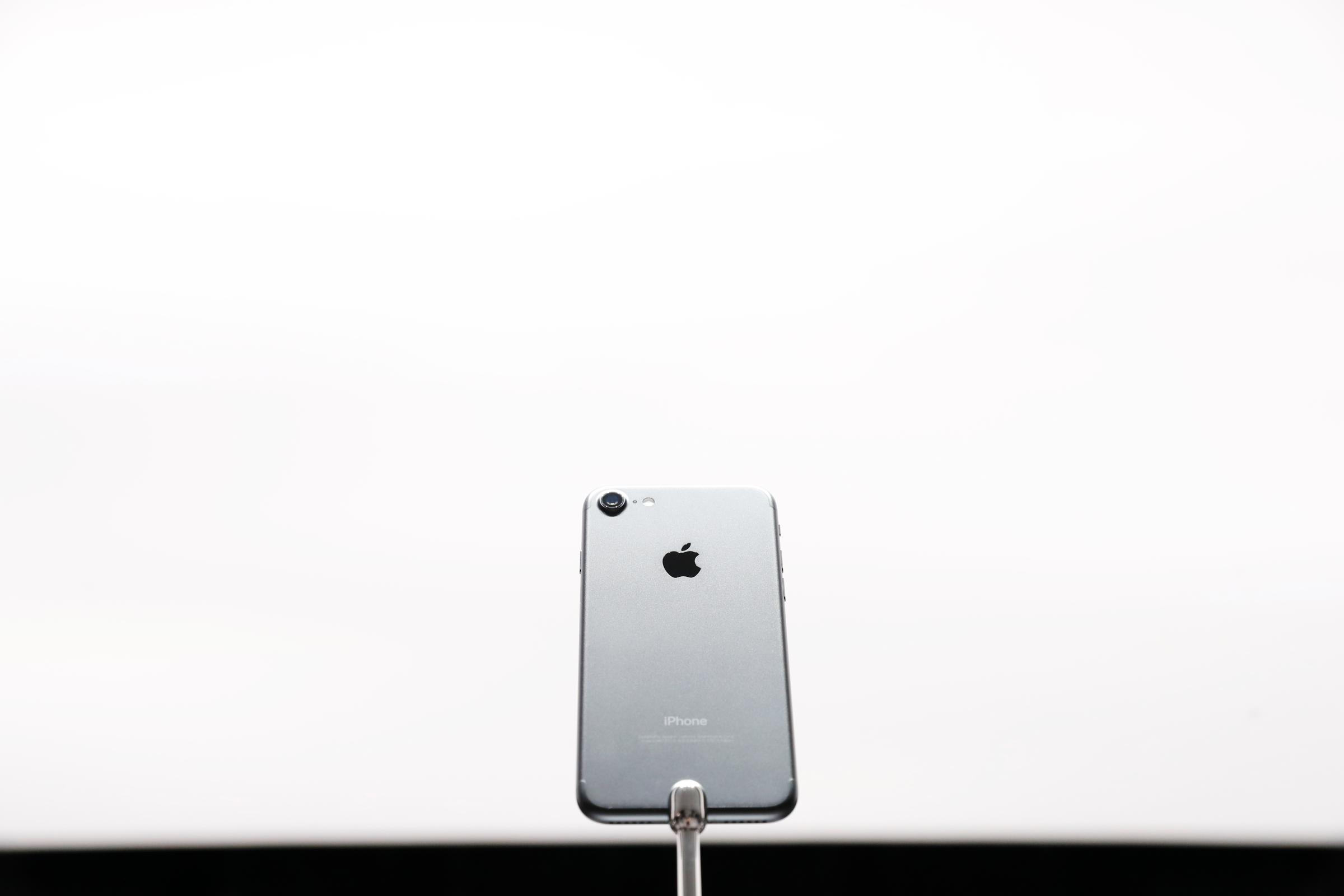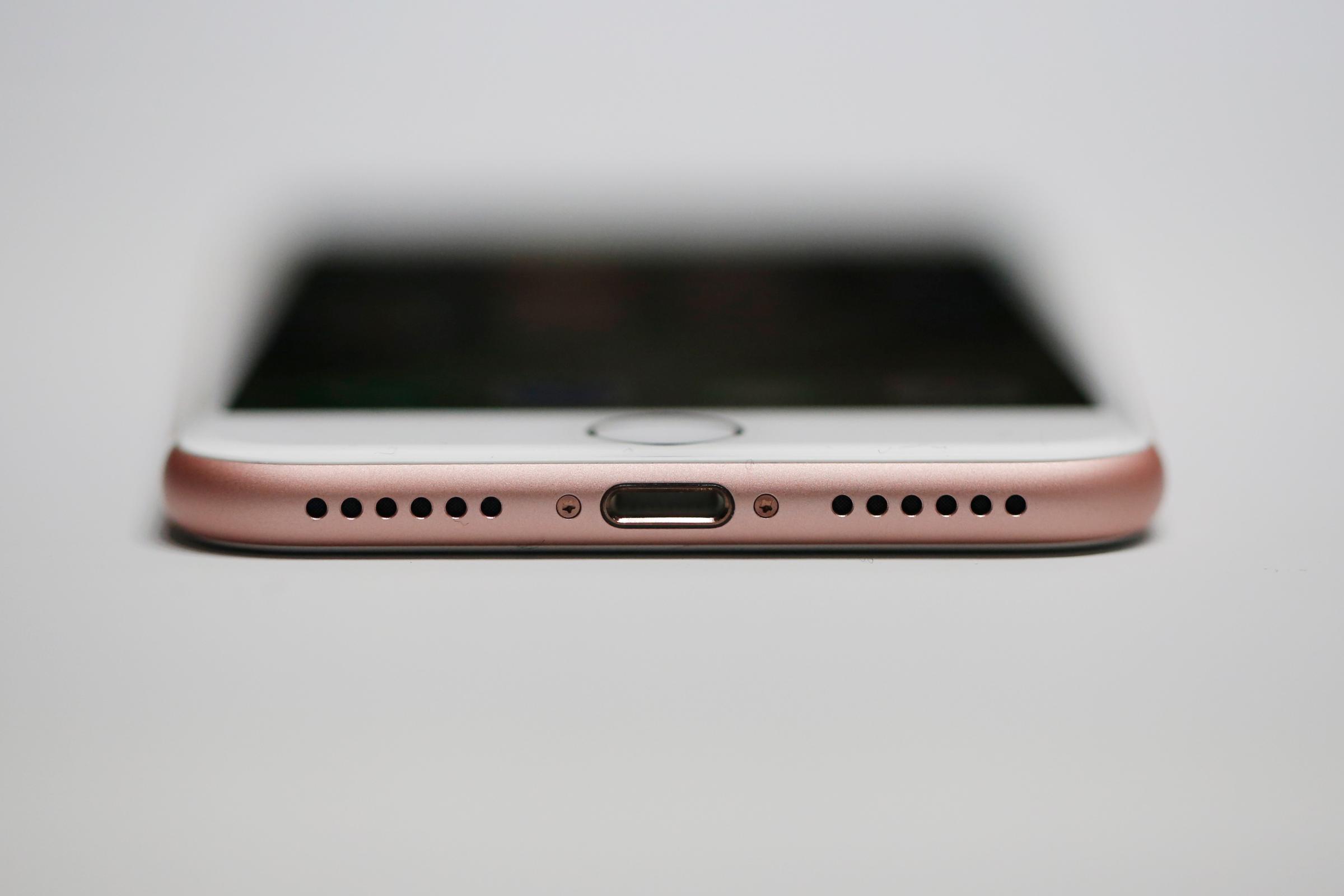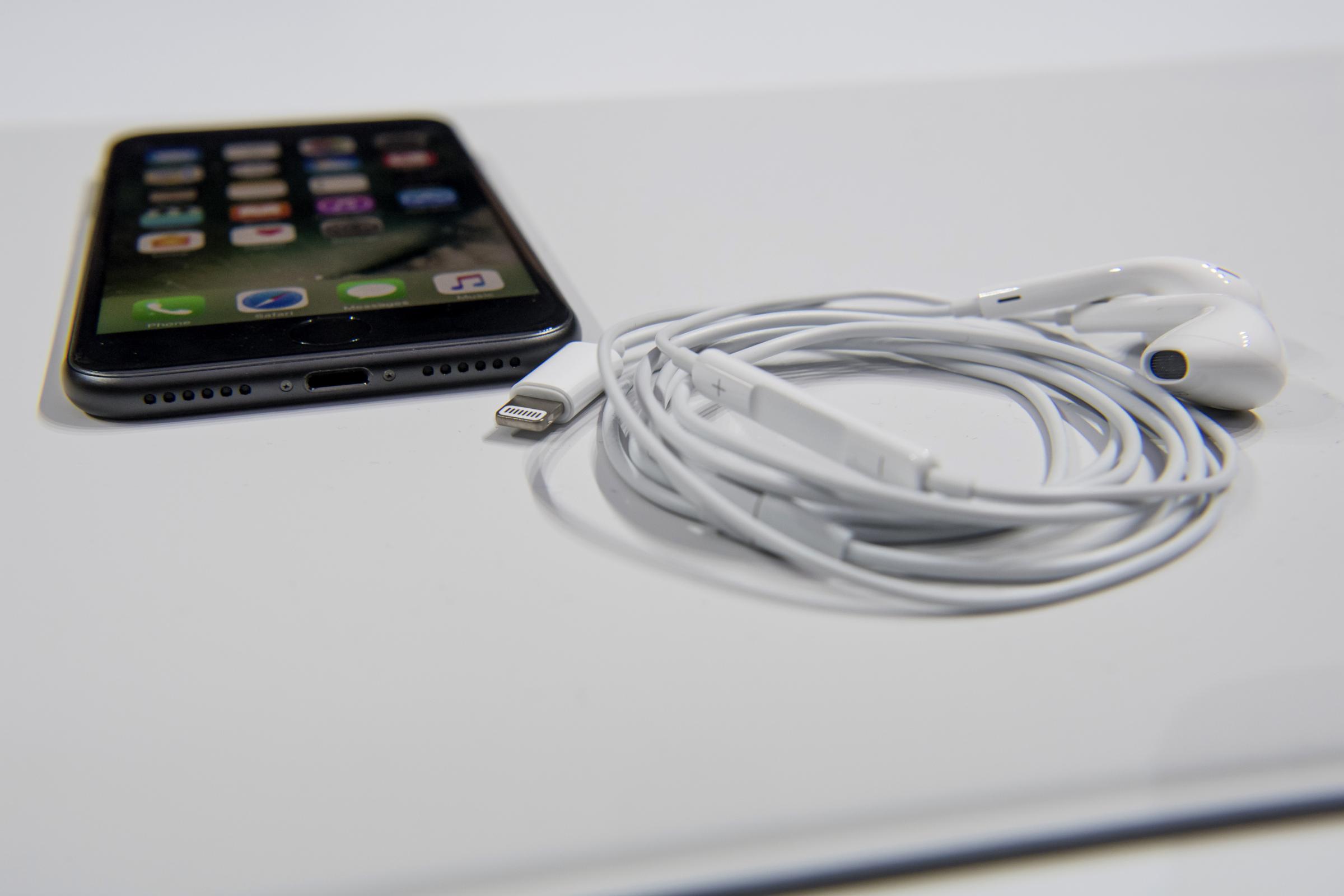The good: Improved camera, Long battery life, Fast performance, Cheapest option starts at 32GB instead of 16GB
The bad: Takes longer to charge than rival devices, Lack of a headphone jack can be inconvenient
Who should buy: Apple fans upgrading from an older model and anyone interested in mobile photography
Save a few tweaks, Apple’s new iPhone 7 and iPhone 7 Plus look plenty similar to their predecessors — at least on the outside. But internal changes are abound, from an amped-up processor to an upgraded camera.
This year’s iPhone marks a turning point for the Cupertino, Calif. company. Apple has long followed a “tick-tock” pattern for its iPhones. In a “tick” year, the company reveals a dramatic redesign, as it did with the iPhone 6 and its larger screen in 2014. In a “tock” year, Apple offers an incremental update to the previous model, like it did with the iPhone 5s, which looked like the iPhone 5 but with a new fingerprint scanner.
Apple is now straying from that cycle, introducing an iPhone — the iPhone 7 — that looks remarkably similar to the iPhone 6 and 6s. Rather than giving the 7 a complete exterior makeover, Apple improved characteristics like battery life, camera quality, and physical durability. That’s a risky move for the company, which has until now been able to count on big, easily noticeable upgrades every two years to juice sales of the iPhone, its best-selling product.
Read more: We took Apple’s iPhone 7 to Zion National Park
So what’s noteworthy about the iPhone 7 and 7 Plus? For one, they’re the first Apple smartphones officially certified as water resistant. Their upgraded cameras take in more light, while the larger Plus model features a second lens for zooming. Under-the-hood processor improvements mean faster performance and better battery life. In these ways and others, Apple is catching up to its smartphone rivals, notably Samsung, which makes some of the best Android phones available.
I’ve been using the iPhone 7 and iPhone 7 Plus as my primary phone for the past several days. Here’s a closer look at what it’s been like to use them.

Look and Feel
Yes, the iPhone 7 looks very similar to the iPhone 6s. But there are some subtle changes. Most notably, the iPhone 7 and iPhone 7 Plus come in two new finishes, Black and Jet Black. The standard Black model is similar to Apple’s other finishes, but in a darker shade than the Space Gray variant. It has a clean, matte look that feels fresh alongside Apple’s gray and silver options. Meanwhile, the Jet Black finish is a striking departure from Apple’s usual style. It has a glossy, piano-like look that vaguely resembles the iPhone 5C’s shiny aesthetic. It’s nice, but there’s a drawback: The Jet Black model is a magnet for fingerprints and other smudges, meaning buyers will probably want to add a case that largely hides the finish anyway.
Flip over the iPhone 7 and you’ll notice another physical change. Gone are the antenna lines that stretch across the back of the phone. Apple has instead embedded them in a less noticeable location toward the top of the device. (They’re practically invisible on the new Jet Black and Black finishes.) It’s a subtle tweak that distinguishes the iPhone 7 from many similar-looking rivals. But again, if you plan to use a case, you won’t notice this change.
The real trick to telling the iPhone 7 apart from its predecessor is flipping it upside-down in search of a headphone jack, because the new iPhone doesn’t have one. That’s a highly controversial move. Anybody who wants to bring their old, wired headphones to this particular party will need to use Apple’s included adapter, which connects them through the iPhone 7’s Lightning port. (Apple also includes a pair of its wired earbuds that connect the same way; it’s separately selling a pair of wireless earbuds we’ll discuss separately.)

How big of a deal is headphone jack’s disappearance? Music fans who’ve splurged on high-end headphones may be peeved about keeping track of an additional adapter that might be easily lost; replacements will cost $9.99. And iPhone 7 users won’t be able to listen to songs through wired headphones and charge their phone at the same time without an optional dock. But for people who just want to listen to music on their morning commute or during a jog, Apple’s included earbuds will do just fine.
Another difference becomes apparent only when actually using the iPhone 7. The home button that sits below the screen isn’t a “button” in the most traditional sense, meaning it doesn’t depress when pushed. Instead, it’s powered by Apple’s “Taptic Engine,” a vibration device also found on the latest MacBooks and the Apple Watch. When you click the iPhone 7’s home button, the Taptic Engine produces a clicking sensation mimicking an actual press.
The button takes a little getting used to, especially if you haven’t used the Taptic Engine on other Apple gear. And it doesn’t necessarily make it easier to unlock your phone or launch Siri. But it does make the iPhone experience feel more consistent overall, as the iPhone’s “3D Touch” provides a similar sensation. Since Apple no longer uses a mechanical button for the home key, there’s also less of a chance it will malfunction after extended use.
Why get rid of the headphone jack and a “true” home button? The changes helped Apple reach a larger goal: Water resistance. Apple’s iPhone 7 and iPhone 7 Plus can be submerged in up to one meter of water for 30 minutes, which should mean an accidental drop in the pool or a sudden rainstorm will no longer put the device’s life in jeopardy. After dunking my iPhone 7 in roughly one foot of water multiple times, the device continued to work flawlessly. Samsung’s Galaxy S7 has a slightly higher tolerance level; it can survive in five feet of water for up to 30 minutes.

Camera
Both of Apple’s new iPhones have gotten a noticeable boost when it comes to photography. This is especially apparent in three specific areas: low-light performance, color capture, and, for the iPhone 7 Plus model only, zooming.
To be blunt: Yes, the camera on this year’s iPhone is definitely an improvement over that of the iPhone 6s. The new phones’ cameras shoot beautifully vibrant photos, making those taken with the iPhone 6s almost look dull in comparison. This was a much needed boost, as rivals like Samsung have been steadily improving their cameras.
We Tested the iPhone 7’s Camera in Zion National Park













Apple’s approach towards photography has long been different from that of its competition. iPhones typically capture scenes more in tune with how they look in real life, instead of exaggerating colors for an easy but less accurate “pop.” This year, Apple has upped the colors just enough to make the iPhone’s photos appear more vivid without going too far.
Some samples and comparisons below:
iPhone 7

iPhone 7 Plus

Samsung Galaxy S7

Motorola Moto Z Droid

iPhone 6s

Apple fans serious about mobile photography will probably want to opt for the iPhone 7 Plus model, which features a big benefit missing from the smaller model: A second camera lens. This extra lens, which is telephoto instead of the typical wide-angle glass, is designed to take better zoomed-in photos, long an Achilles’ heel of smartphone cameras. The lens can physically zoom up to 2x, with digital zoom taking it the rest of the way to 10x. Apple’s other iPhones can only zoom up to 5x, and that’s all digital zoom. (Physical zoom typically offers a better-quality photo than digital zoom, which is effectively equivalent to cropping a photo after it’s been taken.)
The iPhone 7 Plus’ telephoto lens offers an unprecedented level of detail while zooming. Below, you can see the photos I captured of a chalkboard sign outside a local restaurant while zoomed in as far as possible. You’ll notice the text in the image taken with the iPhone 7 Plus looks much crisper. That’s not to say you’ll achieve perfectly sharp photos while zooming — there’s only so much you’ll get from a smartphone compared to a telephoto lens on a high-end camera. But it’s impressive nonetheless for a smartphone.
iPhone 7

iPhone 7 Plus

Samsung Galaxy S7

Motorola Moto Z Droid

iPhone 6s

Apple’s new iPhones are also much better at taking photos in low light, thanks to a wider aperture (f/1.8, instead of f/2.2) and a new four-LED flash that’s 50% brighter than previous models. In my testing, the improved flash felt better at lighting subjects more evenly and capturing accurate skin tones compared to past iPhones. But the flash didn’t light scenes as evenly as Samsung’s Galaxy S7 did under the same conditions — though the iPhone 7’s flash was brighter.
For the selfie-takers out there, Apple’s latest iPhones also pack improved the front-facing cameras. Both devices come with a new 7-megapixel front camera, a modest improvement over the last model’s 5 megapixels. The difference isn’t too noticeable compared to the iPhone 6s, but it outranks both Samsung and Motorola’s latest phones when it comes to taking great selfies. Samsung’s Galaxy S7 makes the colors in selfies look bolder, but its images aren’t as detailed as the front-facing photos taken with the iPhone 7. The Galaxy S7’s front camera also struggled with lighting in my testing scenario, resulting in a photo that had a yellowish tint compared to the iPhone’s.
Using It
Apple’s new iPhones are powered by the company’s latest processor, the A10 Fusion. The new hardware packs four cores, double that of the A9, with two designated for high-performance tasks and an additional pair optimized for efficiency. The two performance cores alone are 40% faster than the A9 chip inside the iPhone 6s and twice as speedy as the iPhone 6’s A8, according to Apple. The improved performance is somewhat noticeable in everyday tasks: the iPhone 7’s camera launches slightly faster than that of the 6s, and the phone unlocks just a hair quicker as well. These enhancements are more prominent when using more resource-greedy apps, like Prisma, which uses artificial intelligence to edit photos in the style of famous artists. With the iPhone 7, the Prisma app was able to work its apparent magic a few seconds faster than it does on the iPhone 6s.
The new A10 Fusion chip also contributes to the new iPhones’ improved battery life. While you’re chatting, snapping and gaming away, the iPhone 7 is busy determining which core should be used at any given moment, making it better at power management.
Indeed, Apple claims the iPhone 7 can last up to two hours longer than the iPhone 6s on a full charge. I’ve found that to be generally true, although battery life will always vary depending on how you use your phone. The iPhone 6s usually gets me through a full day and can just scrape by until the early morning if I don’t plug it in overnight. By contrast, the iPhone 7 provided a full work day’s worth of use and survived until around 10:30 am the next morning, which falls about in line with Apple’s claims. (My daily smartphone usage typically consists of streaming music, sending text messages, checking Facebook and Twitter, sending and reading email, browsing the web, occasionally playing games, streaming video, and using Bluetooth accessories. If this sounds like your routine, you can likely expect similar results, but those looking for more battery power might want to opt for the 7 Plus and its beefier battery.)
It’s worth noting here that while Apple has managed to improve the iPhone’s battery life, it hasn’t sped up the charging process itself. Some Android smartphones, like the Samsung Galaxy S7 and OnePlus 3, support quick charging technology; OnePlus says its phone can recharge up to 60% after being plugged in for just 30 minutes. (Samsung, it should be said, is currently embroiled in a massive recall involving battery issues with its Galaxy Note 7.)

If you often listen to music or watch movies on your phone without headphones, you’ll be happy to know the iPhone 7 and iPhone 7 Plus are the first Apple smartphones with stereo speakers. Audio from TV shows, games and music all sounds deeper and richer here compared to the iPhone 6s. Still, you’ll get better sound out of almost any pair of headphones.
The Taptic Engine powering the iPhone 7’s home button is also front-and-center in Apple’s new smartphone software, iOS 10. The refreshed user interface is loaded with elements that take advantage of the engine’s vibrations — switching on an alarm in the Clock app produces a subtle but satisfying click, for example. Android phones have used vibrations in similar ways for years, especially for on-screen keyboards and navigational buttons. And for the first time, Apple is opening the iPhone 7 and 7 Plus’ Engine to third-party app developers, so they can use it in their apps and games. How useful this becomes largely depends on the developers.
Conclusion
Speaking with CNBC earlier this year, Apple’s CEO teased that the company would “give you things that you can’t live without that you just don’t know that you need today.” Do the iPhone 7 and iPhone 7 Plus live up to that statement? Not quite.
If you’re already carrying an iPhone 6s, there’s little need to upgrade, unless you’re a photography nut or desperately need better battery life. And many of the most exciting changes Apple has in store are actually part of iOS 10, the software upgrade that will also be available for older iPhones. That said, the modest improvements make these the best iPhones Apple has made to date — but it’s nowhere near as big of an upgrade as the iPhone 6 was compared to past models.
The iPhone 7 may be evidence that gone are the days when a new smartphone could truly wow the world. After all, there’s only so much functionality you can pack in these devices before you enter the realm of the superfluous. Apple’s rivals are experimenting features that represent brilliant feats of engineering, like eye scanners that let you unlock your phone by looking at it, curved screens, and virtual reality support.
But perhaps what Apple realizes is that what most people want from their phones is simpler than all that: Long battery life, durability, and a great camera. There’s certainly room for improvement — quick-charging would be nice — but the iPhone 7 delivers on these vital points. It doesn’t “wow” like so many Apple products have. But then again, maybe it doesn’t need to. It’s not a huge upgrade, but it helps Apple’s smartphone remain one of the best around.
4 out of 5 stars
More Must-Reads from TIME
- Why Trump’s Message Worked on Latino Men
- What Trump’s Win Could Mean for Housing
- The 100 Must-Read Books of 2024
- Sleep Doctors Share the 1 Tip That’s Changed Their Lives
- Column: Let’s Bring Back Romance
- What It’s Like to Have Long COVID As a Kid
- FX’s Say Nothing Is the Must-Watch Political Thriller of 2024
- Merle Bombardieri Is Helping People Make the Baby Decision
Contact us at letters@time.com